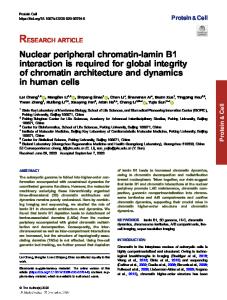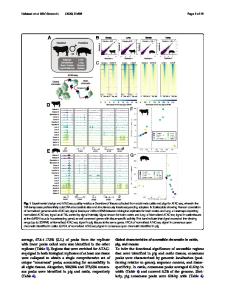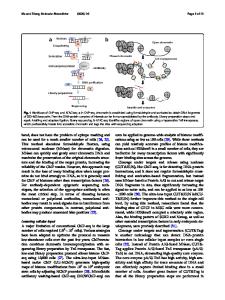Universal NicE-seq for high-resolution accessible chromatin profiling for formaldehyde-fixed and FFPE tissues
- PDF / 2,707,744 Bytes
- 14 Pages / 595.276 x 790.866 pts Page_size
- 99 Downloads / 273 Views
METHODOLOGY
Open Access
Universal NicE-seq for high-resolution accessible chromatin profiling for formaldehyde-fixed and FFPE tissues Hang Gyeong Chin1†, Zhiyi Sun1†, Udayakumar S. Vishnu1, Pengying Hao1, Paloma Cejas2,3, George Spracklin1, Pierre-Olivier Estève1, Shuang-yong Xu1, Henry W. Long2 and Sriharsa Pradhan1*
Abstract Accessible chromatin plays a central role in gene expression and chromatin architecture. Current accessible chromatin approaches depend on limited digestion/cutting and pasting adaptors at the accessible DNA, thus requiring additional materials and time for optimization. Universal NicE-seq (UniNicE-seq) is an improved accessible chromatin profiling method that negates the optimization step and is suited to a variety of mammalian cells and tissues. Addition of 5-methyldeoxycytidine triphosphate during accessible chromatin labeling and an on-bead library making step substantially improved the signal to noise ratio while protecting the accessible regions from repeated nicking in cell lines, mouse T cells, mouse kidney, and human frozen tissue sections. We also demonstrate one tube UniNicE-seq for the FFPE tissue section for direct NGS library preparation without sonication and DNA purification steps. These refinements allowed reliable mapping of accessible chromatin for high-resolution genomic feature studies.
Introduction The eukaryotic nuclear genome is packaged into chromatin, consisting primarily of DNA, proteins, and RNA, which is further condensed into larger folded chromosome structures during cell division. During cellular events, chromatin undergoes remodeling providing accessibility to DNA-binding proteins including transcription factors [1–3]. Gene promoters and enhancers participate in gene expression and confer to accessible chromatin structure. Recent genome-wide methods and studies for mapping chromatin accessibility (open chromatin), nucleosome positioning, and transcription factor occupancy have utilized a variety of methods including DNase hypersensitive region sequencing (DNase-seq) [4], Assay for Transposase-Accessible Chromatin using * Correspondence: [email protected] † The authors Hang Gyeong Chin and Zhiyi Sun contributed equally to this work. 1 New England Biolabs, Inc., 240 County Road, Ipswich, MA 01938, USA Full list of author information is available at the end of the article
sequencing (ATAC-seq) [5], and nicking enzyme assisted sequencing (NicE-seq) [6]. Although both DNase-seq and ATAC-seq are powerful methods, they both require specific reagents and cell type-specific optimization including cell number to enzyme/Tn5 transposon concentration and time of incubation [4, 5]. While ATAC-seq works primarily on unfixed cells, mitochondrial DNA sequence contamination was a major issue until a modified Omni-ATAC-seq protocol was developed [7]. Our previously published NicE-Seq method also required similar enzyme titration in each cell type to determine an optimal enzyme to cell ratio for effective labeling and capture of accessible chromatin regions. Therefore, all the
Data Loading...











